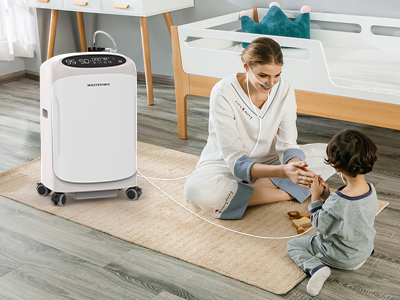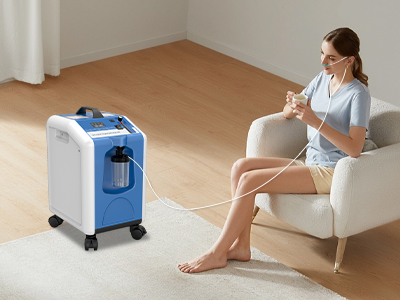14 Feb 2025
Oxygen therapy is a cornerstone of treatment for patients suffering from a range of respiratory conditions. From chronic obstructive pulmonary disease (COPD) to acute respiratory distress syndrome (ARDS), adequate oxygenation and great quality oxygen concentrator is essential to sustain life and improve the quality of life for individuals with compromised lung function.
Oxygen concentrators have become an integral part of this therapy, offering a continuous supply of pure oxygen for patients in both hospital settings and at home. For medical professionals, understanding the ins and outs of oxygen concentrators is crucial in providing optimal care. This knowledge helps ensure patients receive the right therapy and can effectively manage their condition.

How Oxygen Concentrators Work: The Basics
At their core, oxygen concentrators function by extracting ambient air and concentrating its oxygen content. The process begins with air intake, where the concentrator uses a filter to remove impurities. Then, using a molecular sieve or similar technology, the device separates nitrogen from oxygen, ensuring a higher concentration of pure oxygen is delivered to the patient.
Key components of an oxygen concentrator include:
Compressor: Compresses the ambient air to increase pressure. Molecular Sieve Bed: Separates oxygen from nitrogen and other gases. Oxygen Delivery Port: Delivers the purified oxygen to the patient via a nasal cannula or mask. Oxygen concentrators can provide a continuous or pulsed flow, depending on the model and patient needs.
Indications for Oxygen Therapy: When and Why to Prescribe
Oxygen therapy is prescribed to patients whose blood oxygen levels fall below normal, often indicated by oxygen saturation (SpO2) levels under 90%. Conditions like COPD, pneumonia, pulmonary fibrosis, heart failure, and even sleep apnea may require oxygen therapy.
Medical professionals must consider factors such as the patient’s oxygen saturation, activity level, and overall health when deciding on oxygen therapy. The following guidelines help determine the appropriate circumstances for prescribing oxygen therapy:
Chronic Conditions: For patients with chronic respiratory diseases, long-term oxygen therapy can improve survival rates and reduce hospital admissions.
Acute Exacerbations: In cases of acute respiratory failure or exacerbations of chronic conditions, oxygen therapy can prevent organ damage by maintaining adequate oxygen levels.
Post-Surgical Recovery: Oxygen therapy may be needed to support patients recovering from major surgeries, particularly those involving the lungs or cardiovascular system. By carefully assessing the patient’s condition, physicians can recommend an appropriate oxygen delivery method and concentration.
Choosing the Right Oxygen Concentrator for Your Patients
Choosing the right oxygen concentrator depends on the patient’s specific needs, lifestyle, and medical condition. Key factors to consider include:
Flow Rate: Oxygen concentrators come with adjustable flow rates, typically between 1 to 5 liters per minute (LPM) for stationary units and up to 3 LPM for portable models. The flow rate must align with the prescribed oxygen dosage. Portability: For patients who need oxygen therapy on the go, portable concentrators are crucial. These lightweight, battery-operated devices offer mobility without compromising oxygen delivery. Duration of Use: Stationary concentrators are ideal for continuous use at home, while portable concentrators are best for short-term use or travel. Patient Preferences: Some patients may prefer quieter devices or those with advanced features like a pulse dose system that adjusts oxygen delivery based on the patient’s breathing rate. Each patient’s unique requirements will dictate which concentrator best fits their needs, ensuring therapy is both effective and convenient.

Clinical Efficacy and Performance Metrics
When evaluating the efficacy of oxygen concentrators, medical professionals should consider key performance metrics:
Oxygen Purity: The oxygen concentrator should deliver a consistent, high level of oxygen purity, typically between 90-95%. Flow Stability: Oxygen delivery must remain steady, especially during physical exertion or periods of respiratory distress. Reliability: The device must provide consistent performance over an extended period without significant breakdowns or malfunctions. Clinical studies have demonstrated that oxygen concentrators improve patient outcomes, such as increased exercise tolerance, reduced breathlessness, and enhanced survival rates in individuals with chronic lung diseases.
Patient Education and Compliance
Proper patient education is critical to ensure the success of oxygen therapy. Medical professionals should focus on:
Understanding the Therapy: Explain the importance of maintaining prescribed oxygen levels and adhering to therapy. Proper Usage: Instruct patients on how to properly use and care for their oxygen concentrator, including the correct attachment of cannulas or masks and how to adjust settings. Managing Discomfort: Address common concerns, such as nasal dryness or discomfort, and recommend solutions like humidification or skin protection. By fostering a solid understanding of the equipment and its role in therapy, patients are more likely to adhere to the prescribed regimen.
Safety Protocols and Precautions
The safety of oxygen therapy should always be a priority. Essential safety precautions include:
Avoiding Flammable Materials: Oxygen-enriched environments are highly flammable. Patients should be educated on the risks associated with smoking or using flammable products around oxygen concentrators. Monitoring Oxygen Saturation: Regularly check SpO2 levels to ensure the patient’s oxygen levels are maintained within the prescribed range. Device Maintenance: Routine servicing of the oxygen concentrator is necessary to avoid malfunctions and ensure continued efficacy. By following these safety protocols, the risk of complications and accidents can be minimized.
Maintaining and Servicing Oxygen Concentrators
Routine maintenance is essential to keep oxygen concentrators functioning efficiently. Medical professionals should ensure patients or caregivers:
Clean the Filter Regularly: Filters should be cleaned or replaced according to the manufacturer’s instructions to maintain optimal airflow. Monitor for Faulty Parts: Check for signs of wear and tear, such as reduced oxygen flow or unusual noise levels. Service the Device as Needed: Depending on usage, the concentrator may require periodic professional servicing to ensure it operates at peak efficiency. Proactive maintenance helps prolong the life of the concentrator and ensures continuous, reliable oxygen therapy.
Innovative Trends in Oxygen Therapy and Concentrators
The field of oxygen therapy is continuously evolving, with innovations improving the functionality and accessibility of oxygen concentrators. Notable advancements include:
Smart Oxygen Concentrators: Devices equipped with real-time monitoring and reporting capabilities, enabling remote patient tracking and data sharing with healthcare providers. Portable, Lightweight Models: Enhanced battery life and portability options are enabling greater freedom for patients, especially those with active lifestyles. Integration with Telemedicine: Oxygen concentrators are increasingly integrated with telemedicine platforms to allow remote consultations and management of oxygen therapy. Staying abreast of these innovations ensures medical professionals can provide the most up-to-date care options for their patients.
Conclusion
Oxygen concentrators are essential tools in the management of various respiratory conditions. With their proven clinical efficacy, the right oxygen concentrator can significantly improve a patient's quality of life. Medical professionals who understand how to effectively select, prescribe, and monitor these devices are better equipped to support patients in their journey to better respiratory health.
Keywords: oxygen concentrator
Originally published 14 Feb 2025, updated 14 Feb 2025.